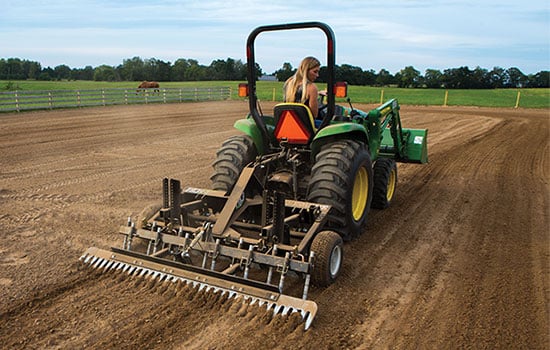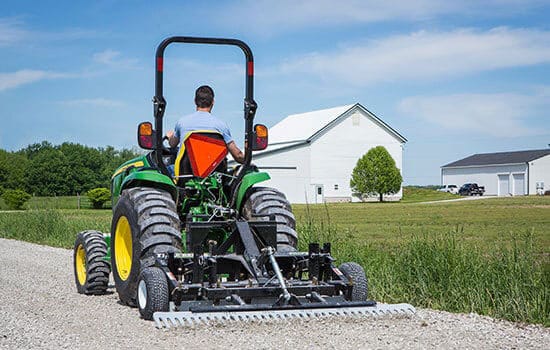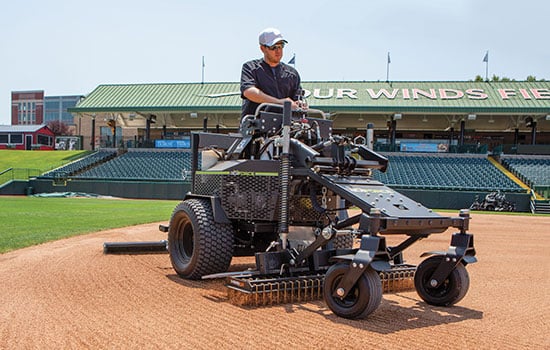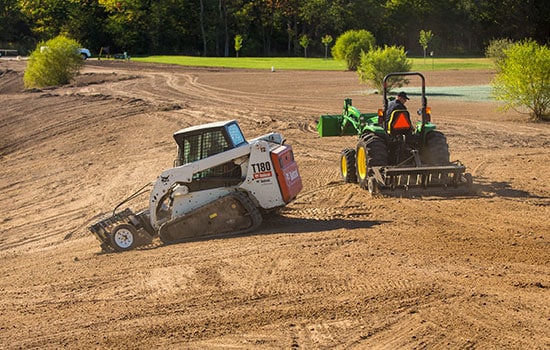Boyd Polhamus – ABI Speedmaster
Transcript
We’re here in Houston, Texas, we met up with Boyd Polhamus. And if you don’t know who Boyd is then and if you’re in the rodeo business, then you are probably living under a rock because Boyd, you have been around.
I really have. let me tell you, Scott, I’ve been blessed to announce some of the biggest rodeos in the country, but I feel the need to confess something. So I contacted you guys.
You did.
OK. And let me tell y’all why. I was at Fort Madison, Iowa, at the Tri-State Rodeo. It was the first time in my life I’d ever seen a SpeedMaster. And the first thing that struck me was how it was built. They had both a display model and then they had when they were using the work the arena. So the first thing I do is walk around and look at the way it was built. Wow. This thing is going to last a while. You couldn’t wear it out. And then I actually watched Ron Stephenson, who’s the ground guy in Fort Madison, work the ground with this tool. And it was one of the most amazing pieces of equipment I’ve ever seen in my life. And I thought to myself, I wonder why I haven’t seen this more often. Where’s it been hiding? Because when you think about the horse flesh that we use in the rodeo industry, it’s diverse, whether it’s a bucking horse, a barrel horse or a guy bulldogging or calf roping. You know, we need those horses to perform at their top level, both inside the arena and inside the practice arena. It just shocked me that I hadn’t seen one before. So I just want to get it out right away that I reached out to you.
There’s a real hole in the rodeo and the barrel in the speed events because the industry’s been using the same technology for 30 years.
No pun intended on the hole. Because there is. And I just often think and and again, I don’t put my horse to a lot of trauma. You know, announcing a rodeo horseback is not hard on a horse. But I watch barrel racers go in to corners and I watch calf roping horses bury their butt with a 275 pound calf at the end of it. And I’ve seen the bucking horses slip and fall. And when we were done in Fort Madison and I looked at how well the horses perform there, how even the runs were for the cowgirls in the barrel racing. I had to reach out to y’all, going; OK, tell me about this piece of equipment. Because. Because, look, I know of other places that could use it. And probably the most important place that should have it is the competitors backyard, Scott. Because you think the amount of money that they spend and supplements, the injections to keep their horses sound, and then they end up, even if they’re blessed, to go to a place that has, you know, the SpeedMaster. Still, they spend the majority of their time at home working on something that’s less than that. And I would venture to guess that more injuries occur in the home practice pen than actually do where they’re competing for prize money. But but either way, whether it’s at the contest where there’s money up, or whether it’s in your backyard, in your home arena, while you’re where you’re practicing, I think the number one thing you could do for your horse. I mean, you’re going to buy a trailer that’s worth hundreds of thousands of dollars to make sure he rides well, you’re going to fill it full of shavings. Probably the best thing you can do for your horse investment is to have your practice ground and your competition ground be a safe and sound as it possibly can be. And if you’re not doing that, you’re doing two things. You’re probably hurting your horse and you’re also hurting your ability to compete at the next level.
So there’s so many places and as so many places use the same drag for every discipline. And clearly, somebody who’s a show jumper, who’s not going to want the same footing as somebody who’s a reining horse guy. And so to know that y’all have put the time and effort into designing those pieces of equipment that would best suit the discipline. And I know in the rodeo business, one of the things we we struggle with is, look, bulldoggers want a certain kind of ground. Barrel racers want a certain kind of ground. The stock contractors who bucked their horses want a certain kind of ground. And for us, for all those seperate different events, we got to try to find a way to meet in the middle. And that’s why I think the SpeedMaster does that beyond anything that I’ve seen anywhere else.
I mean, what you need, Boyd, you need piece of equipment that has the versatility and the flexibility within the tool, to be able to adjust for the bulldoggers, or for the broncs or whatever, whatever is needed. How ever they want it, the SpeedMaster allows you to change that footing.
And that was something I noticed. I mean, the hydraulics, the different the different options that are available for how you might set it, how deep you know, it’s it’s it’s an amazing piece of equipment. Look, I’ve got to tell you, there’s not many times you pick up the phone and call a friend of yours that, you know, knows the people and go, what’s up with this thing? And I’m thinking, OK, I wonder where they get these built because it’s built well, at the time I saw it, all I could do is marvel at the way it was built. But y’all don’t ship to China to get him built you could save money.
In fact, full disclosure, I see the Priefert name on your sleeve.
Right. Well, and I couldn’t be more proud of you because when it comes to manufacturing, Priefert manufacturing is first class. I mean, when they when they build a grade of product, they can tell you how many gage the steel is because they made sure of it instead of buying the steel from China. And China told them it was 20 gage and was really 22. So my point simply being is, after y’all told me that you would listed Priefert in the construction part of it, it’s still your drag. You guys own it. Sure. But they’re you’re manufacturer of it. I was like, no wonder I could see the quality in the paint to the quality in the weld. So that’s why I’m saying, man. I don’t know how anybody if they used it, you know? 10 Hours a day, every day for 10 years could ever wear one of these things out.
It’s one of our weaknesses. We build things to last.
Think about where we are in a society. I mean, my mom and dad at the same washing machine, probably for the full 30 years I’ve been married 20 and I’ve been through six of them. We’re a throwaway society. But that’s not necessarily good when you need to work your arena and your drag’s broke down, and it’s not doing what you need it to do. So I applaud y’all for not going that route. Yeah, there’s probably more money to be made in replacement parts or repairs and what have you, but I’d much rather I’d be proud to have your name on something that you know is going to last a lifetime.
Absolutely. Boyd One of the reasons that I’m really interested in your perspective is because you have a different look on the rodeo in the speed world than a lot of people we talked to. You know, Trevor Brazile‘s a fan of ours. He uses our equipment, Stran Smith uses our equipment. I mean, I can go on and on and on of the people in this event world, rodeo world that uses one of our pieces of equipment. And you’re looking at these competitors and these horses and you’re looking at the effects of this on them. And it’s just a different perspective.
And I have a I have a much broader view in the case of both Stran and Trevor, you know, world champions both. Right. I mean, if there’s any other reason or any other reason to own one, it would be if that’s what the world champions are using, that’s probably what you ought to be using. But for me, whether I’m horseback or in the announcer’s booth Stran’s just one run, and Trevor’s just one run. I’m looking at it from a global view. OK. From from the beginning to the end of not just the calf roping, but also the barrel racing. And how did the broncs hold up? Because I’m telling you, that’s a part of the rodeo industry. And that’s why I’m going to singing y’alls praises to every rodeo company that I have. Because, you know, what happens is, is if you have bad ground and a horse feels it, he’s not going to buck as hard. He’s going to get scared a little bit. So he’s going to be, like a muddy arena sometimes you’ll feel that mud and they’ll they’ll just be different. They won’t buck the same way. Well, its the same way with bad ground on a dry arena. If a horse doesn’t feel safe, that he’s not going to give you your best trip, which means the cowboy, the rough stock riders not going to have the best chance of winning. Number two, if one falls down, the stock contractor can’t stand you, because that’s an automatic re-ride for the cowboy. That means they’ve got to have that horse back there. OK. And if horses are slipping and falling because of ground conditions, which I would submit is the number one reason horses slip and fall in the rough stock events is because of bad ground conditions. And and and so for all those places that want to improve the quality of their rodeo, they want to improve the quality of the way their horses buck and what their fans actually see. Obviously, having one of these would make a big difference in that. But for me, if I’m Trevor and I go out and I make a steer roping or calf roping run and the ground’s not good for my horse, I notice that in my run. And if I’m Stran I notice that, and if I’m a barrel racer, I notice that. But for me, I’m looking at it from the whole picture of the whole community within the industry. And then again, your products. Yes. They’re not cheap, but they’re affordable. They are affordable, especially when you start comparing them to surgeries. You know, in some of the medical care that you have to put out or the other equipment that you’ll use to keep your horse safe and sound is probably when it comes to soundness, it’s one of the most affordable pieces of equipment you can purchase. And so. So to me, that’s a big a big move. I think that needs to be made in the rodeo world, in the speed event world is making a move to tools that have the ability to give you the ground that you need that allow you to practice and keep your horse’s sound at the same time. You get that and then you’re safe and you’re practicing well.
And we get unfortunately, we get to hear the other side of that story. We get to hear that people call into our office and go. We just had to put our horse down. We should listen to you two years ago or three years ago. We we called and asked about this particular piece of equipment. And now we’ve spent $20000 on vet bills and surgeries. My God, I wish we would listen to you to begin with. That we’re always talking to the customer after the fact. And somehow we got to get to the customer before the fact.
Well, to me and to me, it really is a no brainer. I mean, people buy insurance on the on the fact that something might happen. I’m going to insure this horse in case something happens. The best insurance you could have for your horse is good ground. Because if I mean, my brother’s a farrier, and his favorite deal is no foot, no horse, because I don’t care what you do with your horse, if if his legs and his feet aren’t good, you can’t do it with him. And so his whole attitude as a farrier is no foot, no horse. Right. Well, if you’re a competitor, you should have that same attitude about the soundness, because I know barrel racers who horses come up lame and they’re out there struggling, trying to find another horse. They’re making the NFR or whatever the case may be. They need to find one. And and man, they might have just fixed it, by working their arena correctly with a tool that allows them. You might have you might be in a place where you’ve got clumpy clay. OK, well, SpeedMaster will help you break it up and get it at a depth that’s safe and sound. You might be in a place that has deep sand. Well, they’ll tell you to water the guts out of. SpeedMaster will help you make it right, but it is consistent as you can give that ground to your horse. All you’re doing is ensuring his soundness, not holding the practice pen, but on payday.
And don’t we owe it to the horses?
I Would.
Yeah. We get calls and the customer will say, yeah, but I’m not Trevor Brazile and I’m not Boyd.
Oh, I bet they’re Boyd. Because if they catch a cold they’re Boyd.
But here’s what I tell them. Their horses don’t know any different. Their horse doesn’t know that it’s not Trevor Brazile riding them. That horse deserves to be sound. Deserves to be safe.
You know. I was glad to see the USTRC raise everybody’s numbers because mine finally went up. That’s how bad a team roper I am. But at the same time, I go to a lot of different places and I think just the dollars and horseflesh that are there for my caliber. My caliber of roper. And we’re all out there jackpotting. And you know, it’s a 3 for X, you know, or or draw a pot or what have you. But and I could tell you the horses that slip with 15 year old girls on them and down they go, they don’t have to slip. Does that make sense? I mean, horses shouldn’t slip. I didn’t realize the science behind it. I didn’t realize the amount of time and effort when it came to your equipment. All I did was look at a piece of equipment at the Tri-State Rodeo in Fort Madison. That’s built right. That’s that’s awesome. Then I walked watch Ron Stephenson work the ground and I was like, okay, OK. And so then I went to Will Sullivan and went, Hey, let’s talk about one of these. So now here we are. We’re talking about it together. At the time, you know, because, well, we live in a world where people will take a rototiller and a piece of cyclone fence and drag it behind and think they got their arena worked and all they’re doing is crippling their horses and they don’t even know.
Well, what’s unfortunate is that the average rider doesn’t see below the surface. Right. All they see is that top surface.
And it looks pretty don’t it.
And you take a chain harrow, and you can make that pretty.
Yeah, but it’s that three to four inches that affects the end results. Here’s what kills me though. OK, so now I’m curious, right. So I go to your all’s web site. So I Google click on the Web site and then I start going through all the other equipment you make. And I’m like, I could use that driveway tool. Oh, man. Hey, look at that manure spreader. That could use that manure spreader. And I started going through because I’m sitting here thinking, OK, there’s a specialist company they’re going to build arena drags of different varieties. And then I go and see all the different product lines that you, if they’re all built with the same. And I put my hands on those. But if they’re all built with the same quality, the SpeedMaster is built. Yeah, I’ve got the I wants. It was kind of Christmastime again. I brought my iPad, I’m like, honey, come look at this. Anyway.
So yeah, look I just didn’t realize all the time and effort in the science that went into designing each drag for whether you’re you know, whether you’re reining horse guy or a cutting horse guy, a western pleasure guy, you know, whatever, you know, show, jump, their size, whatever it is you guys are involved in the footing for that. And it really you have no peers because I mean, there’s nobody else that studies arena ground like y’all did. Other people make arena products, but they don’t study it like y’all study it.
Boyd, it’s been a pleasure to talk to you. I’m really glad you took the time out of your day. You drove an hour and half. And that’s that they spoke to me. Now this guy is willing to drive.
Yeah. Well, I was there and I wanted to know more. And I wanted to meet y’all face to face, but I wanted to know more. And this has been very enlightening for me very much so. Thanks Scott.
It’s been a pleasure.
No, my pleasure.



